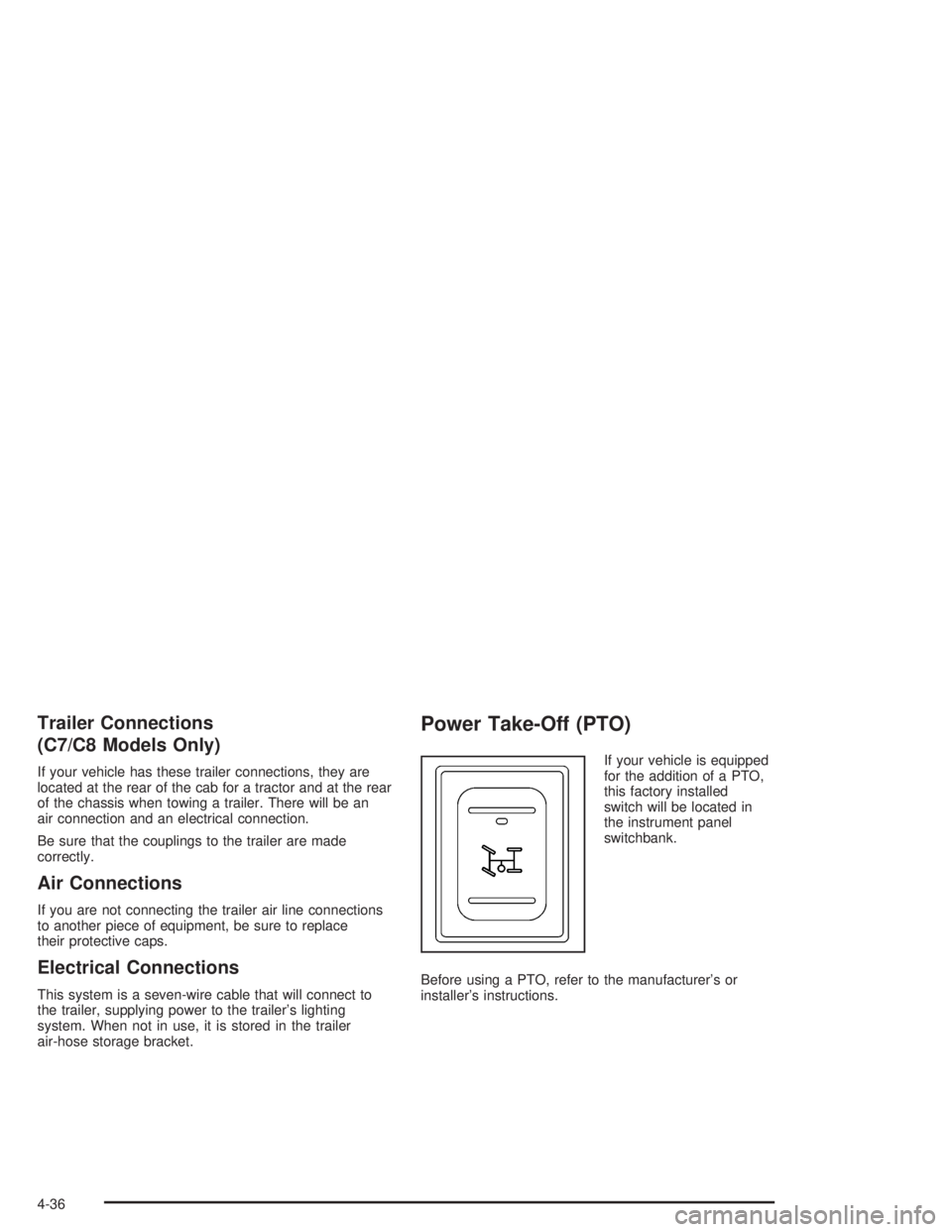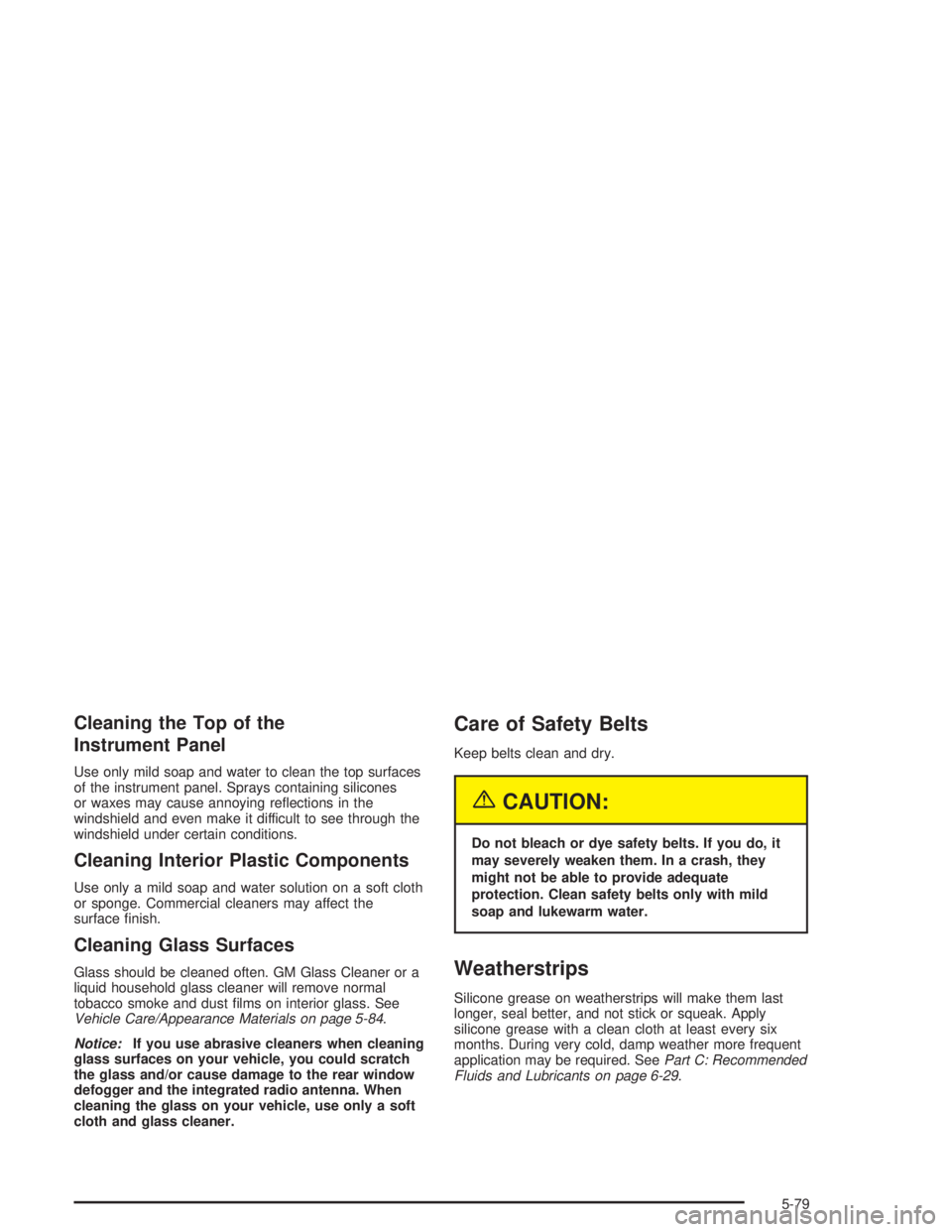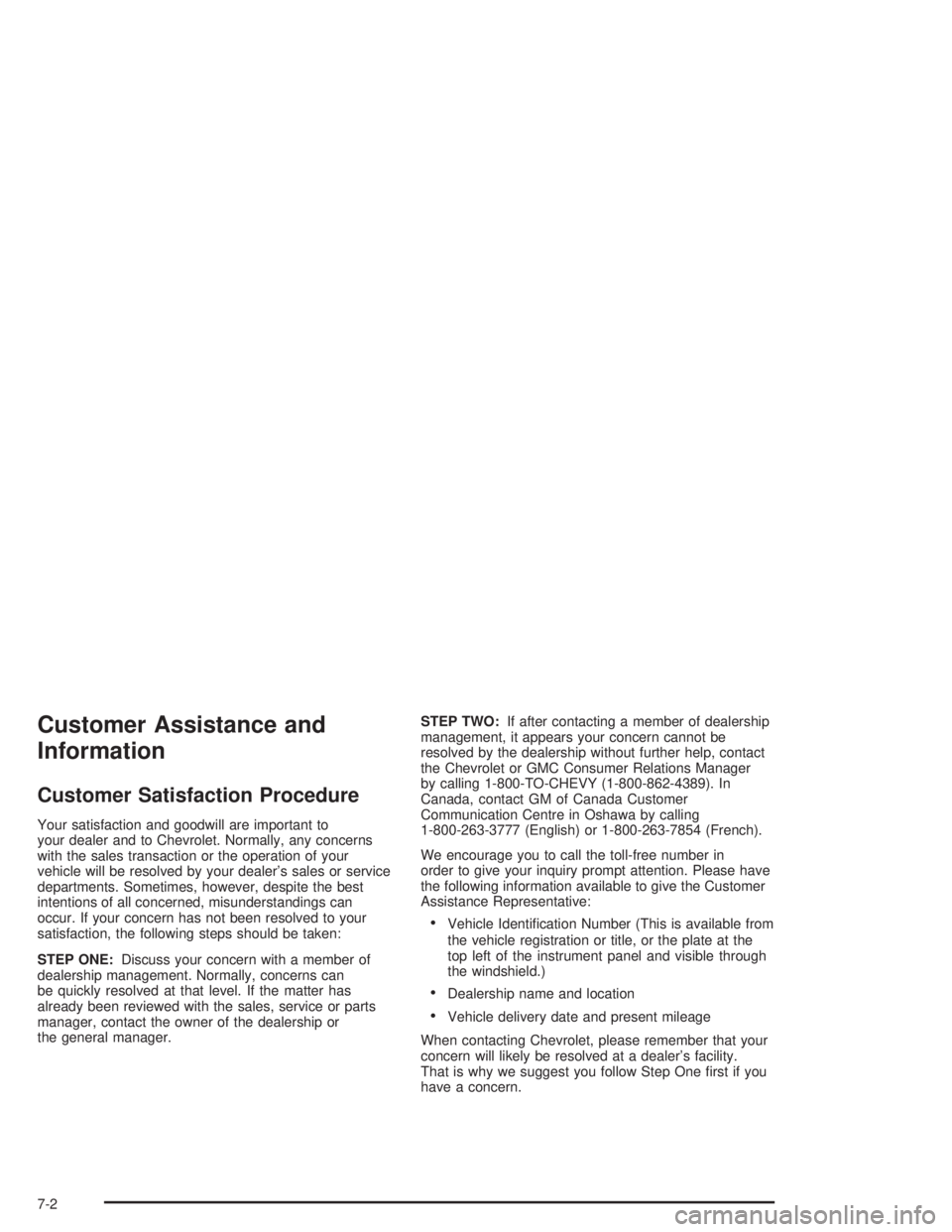2004 CHEVROLET KODIAK instrument panel
[x] Cancel search: instrument panelPage 181 of 366

Traction Control System (TCS)
Your vehicle may have a traction control system that
limits wheel spin. This is especially useful in slippery
road conditions. The system operates only if it senses
that one or both of the rear wheels are spinning or
beginning to lose traction. When this happens,
the system applies the brake(s) at the affected wheel(s).
The bottom light on the TCS on/off button will come
on when the TCS is limiting wheel spin. You may feel or
hear the system working, but this is normal. The TCS
will function at speeds up to about 25 mph (42 km/h).
The TCS may operate on dry roads under some
conditions. When this happens, you may notice a
reduction in acceleration. This is normal and doesn’t
mean there’s a problem with your vehicle. Examples of
these conditions include a hard acceleration in a
turn, an abrupt upshift or downshift of the transmission
or driving on rough roads.
When the light in the top of the TCS button is on, the
TCS is off and will not limit wheel spin. Adjust your
driving accordingly.
The light in the top of the TCS button will come on if the
TCS is turned off by pressing the TCS on/off button.
The light may also come on if a problem has been
detected in either the traction control system or
the anti-lock brake system.The traction control system automatically comes on
whenever you start your vehicle. To limit wheel
spin, especially in slippery road conditions, you should
always leave the system on. But you can turn the
traction control system off if you ever need to. You
should turn the system off if your vehicle ever gets stuck
in sand, mud or snow and rocking the vehicle is
required. SeeRocking Your Vehicle To Get it Outunder
If You Are Stuck: In Sand, Mud, Ice or Snow on
page 4-29.
To turn the system on or
off, press the traction
control button located in
the instrument panel
switchbank.
If you used the TCS button to turn the system off, the
light in the top of the button will come on and stay
on. You can turn the TCS back on at any time by
pressing the button again; the light should go off.
4-11
Page 206 of 366

Trailer Connections
(C7/C8 Models Only)
If your vehicle has these trailer connections, they are
located at the rear of the cab for a tractor and at the rear
of the chassis when towing a trailer. There will be an
air connection and an electrical connection.
Be sure that the couplings to the trailer are made
correctly.
Air Connections
If you are not connecting the trailer air line connections
to another piece of equipment, be sure to replace
their protective caps.
Electrical Connections
This system is a seven-wire cable that will connect to
the trailer, supplying power to the trailer’s lighting
system. When not in use, it is stored in the trailer
air-hose storage bracket.
Power Take-Off (PTO)
If your vehicle is equipped
for the addition of a PTO,
this factory installed
switch will be located in
the instrument panel
switchbank.
Before using a PTO, refer to the manufacturer’s or
installer’s instructions.
4-36
Page 242 of 366

Engine Overheating
You will find a coolant temperature warning gage on
your vehicle’s instrument panel, as well as a low coolant
warning light. Your vehicle also has a check gages
warning light on the instrument panel.
If Steam Is Coming From Your Engine
{CAUTION:
Steam from an overheated engine can burn
you badly, even if you just open the hood. Stay
away from the engine if you see or hear steam
coming from it. Just turn it off and get
everyone away from the vehicle until it cools
down. Wait until there is no sign of steam or
coolant before you open the hood.
If you keep driving when your engine is
overheated, the liquids in it can catch �re. You
or others could be badly burned. Stop your
engine if it overheats, and get out of the
vehicle until the engine is cool.
Notice:If your engine catches �re because you
keep driving with no coolant, your vehicle can
be badly damaged. The costly repairs would not be
covered by your warranty.
5-36
Page 285 of 366

Cleaning the Top of the
Instrument Panel
Use only mild soap and water to clean the top surfaces
of the instrument panel. Sprays containing silicones
or waxes may cause annoying reflections in the
windshield and even make it difficult to see through the
windshield under certain conditions.
Cleaning Interior Plastic Components
Use only a mild soap and water solution on a soft cloth
or sponge. Commercial cleaners may affect the
surface finish.
Cleaning Glass Surfaces
Glass should be cleaned often. GM Glass Cleaner or a
liquid household glass cleaner will remove normal
tobacco smoke and dust films on interior glass. See
Vehicle Care/Appearance Materials on page 5-84.
Notice:If you use abrasive cleaners when cleaning
glass surfaces on your vehicle, you could scratch
the glass and/or cause damage to the rear window
defogger and the integrated radio antenna. When
cleaning the glass on your vehicle, use only a soft
cloth and glass cleaner.
Care of Safety Belts
Keep belts clean and dry.
{CAUTION:
Do not bleach or dye safety belts. If you do, it
may severely weaken them. In a crash, they
might not be able to provide adequate
protection. Clean safety belts only with mild
soap and lukewarm water.
Weatherstrips
Silicone grease on weatherstrips will make them last
longer, seal better, and not stick or squeak. Apply
silicone grease with a clean cloth at least every six
months. During very cold, damp weather more frequent
application may be required. SeePart C: Recommended
Fluids and Lubricants on page 6-29.
5-79
Page 291 of 366

Vehicle Identi�cation
Vehicle Identi�cation Number (VIN)
This is the legal identifier for your vehicle. It appears on
a plate in the front corner of the instrument panel, on
the driver’s side. You can see it if you look through the
windshield from outside your vehicle. The VIN also
appears on the Vehicle Certification and Service Parts
labels and the certificates of title and registration.
Engine Identi�cation
The 8th character in your VIN is the engine code. This
code will help you identify your engine, specifications
and replacement parts.
Service Statement
One of these statements is on your GVW Rating label.
Here is what each one means.
TRUCK SERVICE:A vehicle made to carry property or
special equipment. It is made for uniform frame
loading. That includes using the vehicle to pull a full
trailer.
TRUCK-TRACTOR:A vehicle made to draw other
vehicles. It is made to carry part of the load of the trailer.
It is made for point frame loading, usually for a
semi-trailer (fifth-wheel).
MAX. VERT. CG:The highest allowable vertical center
of gravity, at the highest allowable GVWR. It is
measured from the level ground in inches.
TRUCK-CANADA:A vehicle first sold in Canada with a
non-school bus application, or cab models with regular
production option RQ2 (truck service).
TRACTOR-CANADA:A cab model first sold in Canada
with regular production option RQ3 (truck-tractor
service).
5-85
Page 294 of 366

Instrument Panel Fuse Block
There are two instrument panel fuse blocks located behind the instrument panel on the passenger’s side of
the vehicle.
Be sure to replace fuses with fuses of the same rating. Do not use fuses of higher amperage than those indicated on
the fuse block.
Fuse Block 1
5-88
Page 344 of 366

Customer Assistance and
Information
Customer Satisfaction Procedure
Your satisfaction and goodwill are important to
your dealer and to Chevrolet. Normally, any concerns
with the sales transaction or the operation of your
vehicle will be resolved by your dealer’s sales or service
departments. Sometimes, however, despite the best
intentions of all concerned, misunderstandings can
occur. If your concern has not been resolved to your
satisfaction, the following steps should be taken:
STEP ONE:Discuss your concern with a member of
dealership management. Normally, concerns can
be quickly resolved at that level. If the matter has
already been reviewed with the sales, service or parts
manager, contact the owner of the dealership or
the general manager.STEP TWO:If after contacting a member of dealership
management, it appears your concern cannot be
resolved by the dealership without further help, contact
the Chevrolet or GMC Consumer Relations Manager
by calling 1-800-TO-CHEVY (1-800-862-4389). In
Canada, contact GM of Canada Customer
Communication Centre in Oshawa by calling
1-800-263-3777 (English) or 1-800-263-7854 (French).
We encourage you to call the toll-free number in
order to give your inquiry prompt attention. Please have
the following information available to give the Customer
Assistance Representative:
•Vehicle Identification Number (This is available from
the vehicle registration or title, or the plate at the
top left of the instrument panel and visible through
the windshield.)
•Dealership name and location
•Vehicle delivery date and present mileage
When contacting Chevrolet, please remember that your
concern will likely be resolved at a dealer’s facility.
That is why we suggest you follow Step One first if you
have a concern.
7-2
Page 353 of 366

Care of
Safety Belts................................................5-79
Your Cassette Tape Player............................3-57
Your CD Player...........................................3-59
Your CDs ...................................................3-59
Cassette Tape Messages.................................3-52
CD Adapter Kits.............................................3-52
Center Console Storage Area...........................2-42
Center Passenger Position, Safety Belts.............1-22
Charging System Light....................................3-30
Chassis Lubrication.........................................5-51
Check
Engine Light...............................................3-37
Gages Warning Light...................................3-42
Checking Coolant............................................5-34
Checking Engine Oil................................5-21, 5-25
Checking Things Under the Hood......................5-18
Checking Your Restraint Systems......................1-61
Chemical Paint Spotting...................................5-83
Child Restraints
Child Restraint Systems...............................1-33
Infants and Young Children...........................1-29
Older Children.............................................1-27
Securing a Child Restraint in a Rear
Outside Seat Position...............................1-39
Securing a Child Restraint in the Center
Rear Seat Position (Crew Cab
®) or Center
Front Position..........................................1-41Child Restraints (cont.)
Securing a Child Restraint in the Right
Front Seat Position...................................1-43
Top Strap...................................................1-38
Where to Put the Restraint...................1-35, 1-37
Chime Level Adjustment..................................3-59
Chugger-Snubber Lock-Out Feature.................... 1-7
Cigarette Lighter.............................................3-18
Cleaning
Inside of Your Vehicle..................................5-77
Outside of Your Vehicle................................5-80
Underbody Maintenance...............................5-83
Weatherstrips..............................................5-79
Cleaning Exterior Lamps/Lenses.......................5-80
Cleaning Fabric/Carpet....................................5-77
Cleaning Glass Surfaces..................................5-79
Cleaning Interior Plastic Components.................5-79
Cleaning the Top of the
Instrument Panel.........................................5-79
Cleaning Vinyl................................................5-78
Climate Control System...................................3-19
Outlet Adjustment........................................3-22
Rear Heating System...................................3-23
Clutch Brake (Vehicles with Non-Synchronized
Transmission)..............................................2-32
Clutch Pedal Free Travel.................................5-51
Cold Weather Starting (Diesel Engine)...............2-20
Cold Weather Starting
(Caterpillar
®Diesel).....................................2-15
3